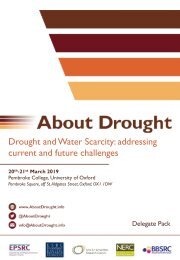About Drought Handbook: Outputs & Impacts
As the UK’s £12m Drought and Water Scarcity (DWS) research programme reaches its conclusion with a final event at The Royal Society in London, this handbook draws together the key outputs and outcomes. The book also features a series of interviews with our leading stakeholders, which highlight how successfully we have met our objectives to produce cutting-edge science that has made a demonstrable impact on how decision-makers manage water scarcity in the UK.
As the UK’s £12m Drought and Water Scarcity (DWS) research programme reaches its conclusion with a final event at The Royal Society in London, this handbook draws together the key outputs and outcomes. The book also features a series of interviews with our leading stakeholders, which highlight how successfully we have met our objectives to produce cutting-edge science that has made a demonstrable impact on how decision-makers manage water scarcity in the UK.
- No tags were found...
Create successful ePaper yourself
Turn your PDF publications into a flip-book with our unique Google optimized e-Paper software.
Jim Hall<br />
WATER SUPPLY<br />
While the UK has a very well evolved<br />
framework for drought and water<br />
resources planning, there remains<br />
a need for innovative approaches<br />
to enhance robustness, particularly<br />
in light of concerns about future<br />
droughts exceeding historical<br />
precedents used for planning.<br />
Similarly, while hydrological<br />
monitoring is advanced, forecasts and<br />
outlooks remain highly uncertain,<br />
hindering their uptake by planners,<br />
despite recent advances. The<br />
methodologies and evidence being<br />
developed in the DWS Programme<br />
have the potential to inform<br />
developments in the operational<br />
drivers in water resources planning<br />
and drought management which are<br />
currently underway.<br />
The timescale of these reforms was<br />
very well matched with the timescale<br />
of the research projects, providing<br />
a window for testing, approval and<br />
uptake.<br />
The Water Supply workstream<br />
has:<br />
1Developed standardised stress<br />
tests and tools for risk-based<br />
water resources planning;<br />
2Provided recommendations<br />
and guidance for hydrological<br />
modelling in practical applications;<br />
3Developed tools to monitor,<br />
forecast and manage drought.<br />
Water Supply worked with a range of<br />
water industry stakeholders (water<br />
companies, regulators, consultancies<br />
etc.) to define the key priorities via<br />
workshops and other engagement<br />
activities early on.<br />
Nevil Quinn<br />
AGRICULTURE<br />
Agriculture is often the first sector<br />
to experience severe impacts in a<br />
drought which can then propagate<br />
rapidly through the fresh produce<br />
supply chain to retailers. Significant<br />
socio-economic impacts and market<br />
responses can then impact on the<br />
primary production sector as well<br />
as many dependent downstream<br />
services including processing,<br />
packaging and distribution. Identifying<br />
drought risks, resilience and<br />
mitigation measures are therefore<br />
central, combined with improved<br />
forecasting and early detection of<br />
drought risk. It is also recognised that<br />
managing agricultural drought risk<br />
needs to be aligned with strategies<br />
to manage risks arising from both a<br />
meteorological drought and changes<br />
in water regulation; both water<br />
scarcity and drought responses need<br />
to be considered collectively.<br />
The Agriculture work stream has:<br />
1Consolidated knowledge, data and<br />
understanding on drought impacts<br />
and responses;<br />
2Guided and influenced national<br />
agricultural policy through<br />
development of a water and drought<br />
strategy for agriculture and food;<br />
3Improved drought planning and<br />
decision-making in the agricultural<br />
sector.<br />
The scope of the Agriculture work<br />
stream was informed by a meeting<br />
of all four DWS Programme projects<br />
with Defra in July 2016 and a<br />
workshop involving key informants<br />
and agricultural stakeholders<br />
including the NFU, UKIA, farmers,<br />
and agriculture-related businesses in<br />
December 2016.<br />
33<br />
Lindsey McEwen<br />
BUSINESS<br />
Large-scale business and SMEs are<br />
critical to the functioning of the<br />
regional and national economy.<br />
Evidence from engagement within<br />
the DRY project suggests that,<br />
particularly with SMEs, drought risk<br />
planning is not on their organisational<br />
radar. Alongside the importance of<br />
increasing business resilience to<br />
drought and water scarcity, UKWIR<br />
(2015) set out the need for business<br />
innovation and the seizing of<br />
opportunities in water markets.<br />
The Business workstream has:<br />
1Translated risk-based<br />
understanding generated in DWS<br />
projects into accessible, risk and<br />
resilience-informed information<br />
systems tailored to the needs of<br />
large businesses, and of business<br />
people planning and running SMEs;<br />
2Translated knowledge and<br />
understanding generated across<br />
the DWS projects into specific,<br />
supporting decision-making tools<br />
and frameworks for business;<br />
3Engaged businesses directly in<br />
drought planning and decisionmaking,<br />
generating wider business<br />
discourse around drought, water<br />
scarcity and water efficiency.<br />
The Business workstream used data<br />
and methodologies developed across<br />
the four DWS projects to work<br />
with different businesses/business<br />
groups (at different scales and types/<br />
scales of water use) and key partners<br />
(e.g. Innovate UK, Federation of<br />
Small Businesses) to co-produce<br />
innovative products and solutions to<br />
support drought risk adaptation and<br />
decision-making. Business linked with<br />
the Water Supply and Agriculture<br />
workstreams, through consideration<br />
of agricultural processing/supply<br />
chain.




